Caution -- Warbird Ramblings Follow, Read At Your Own Risk
by ANN Contributor Tom Griffith
Editor's Note: When we last left ANN's
self-confessed "Warbird Nut" Tom Griffith, he had just spoken with
Colonel Dick Cole, one of the original "Doolittle Raiders" who flew
16 specially-modified B-25s over Tokyo in April 1942, four months
after the attack on Pearl Harbor that catapulted the US into World
War II.

As Tom mentioned in his earlier article, Lone
Star Flight Museum in Galveston, TX recently refurbished its B-25J,
to more closely replicate the earlier B-models flown by the
Raiders. How successful was that restoration? What details were
changed? Tom fills us in below...
While I take great satisfaction in getting to talk to my
personal heroes, US service personnel who fought and won WWII, I
find it easier to "interview" aircraft, their engines and their
armament. You might call me the "Doctor Doolittle (no kin to Jimmy
Doolittle!) of Aircraft" because I talk to (and more importantly,
LISTEN to) old aircraft. I've finally admitted it in print: I'm a
nut, an aircraft nut.
Recently, I reconnected with a B-25 Mitchell -- not only a B-25
Mitchell, but one that has a special place in my life, as we go
back 21 years to Easterwood Airport at College Station, TX. This
beautiful blue and white Mitchell, restored and painted as a US
Navy PBJ (USN terminology: "PB" for "Patrol Bomber" and "J" was the
USN's designation for any aircraft manufactured by North American
Aviation), was named "Special Delivery."

It was love at first sight, and at first sound. I had seen B-25s
before, and the restoration of this most-famous US Army Air Forces
medium bomber as a USN PBJ was instantly intriguing.
The nose art on the PBJ "Special Delivery" was typical of most
WWII vintage nose art, and typical of USN nose art (which was
frowned on officially, but it happened nonetheless), its female
subject is rendered in a manner that is, shall we say, less
risqué than that of most of those of the Army Air Forces.
She has been part of the Lone Star Flight Museum in Galveston, TX
collection since it opened, and like I've already stated, we've
seen her at airshows more than a few times.
I even got a ride in her... and I reported on this in a 2002 ANN article. This
was my first warbird ride and I'll never forget it!

This past April, our nation observed the 65th anniversary of
Doolittle's Tokyo raid... and in honor of this, the Lone Star
Flight Museum, with sponsorship of various organizations and
corporations, made the decision to change the livery of their
beautiful Mitchell from USN colors to those of the US Army Air
Forces, circa 1942. The featuring of Col. Dick Cole at the airshow
dovetailed perfectly with the debut of the "new" aircraft.
The makeover of "Special Delivery" was finished just in time for
this magnificent Mitchell to appear at the LSFM's 2007 spring
airshow. In an e-mail from Larry Gregory (who's been the Head
Honcho at LSFM since the retirement of Ralph Royce in June 2006), I
first found out about the changes to "Special D" only days before
the airshow, which for the first time in two years, our schedule
allowed us to attend. Memberships are not all that expensive, and
I've always felt that even in the last two years when we haven't
visited it, our money helped out, to a small extent, to keep the
LSFM and Texas Aviation Hall going.
After I arrived I passed quickly through the Museum, under the
watchful stare of their BIG project PB4Y-2 Privateer, past their
A-20 Havoc which looked like it was undergoing its annual
inspection and past their magnificent F8F Bearcat (which, by the
way, I haven't seen in the air yet, and wouldn't this trip,
either). Making my way outside to the ramp behind the Museum, I at
once noticed the B-17G "Thunder Bird" that was, indeed, sick, and
in need of a replacement for Engine No. 3. I had known from an
e-mail from Larry Gregory that "T-Bird" would be off of the active
roster, but even with this advanced notice, it was still sad to see
her unable to fly.
Sixty-something year-old things, whether people or planes have
their good days and their bad -- twice, I missed a ride aboard
"T-bird" because of one problem or another before finally getting my
"ride" on my third invitation to fly.
Back to the LSFM ramp: I briefly visited with the Museum's F3F
and a few other "regulars" that I've come to love over the years.
Anyway, making my way west of the Museum buildings, I spotted it: a
dark green upper with grey undersides, a shiny, beautiful "new"
B-25 Mitchell. I almost ran up to meet my old friend and see how
she was doing after her makeover. I was lucky that one of the
Museum's featured Living Legends, Col. Dick Cole, was posing by
Engine No. 1. There was another photographer who also shared my
interest in this particular man and this particular machine --
imagine that!
I was able to capture the new nose art on "Special Delivery."
The full name is "Doolittle Raiders Special Delivery," but I'll
refer to her as "Special Delivery" or "Special D." It's really not
nose art in the actual sense. It has the motto of the Doolittle
Raiders, the French phrase "Toujours Au Danger" that means "Ever
Into Danger." The coat of arms for the Raiders, as well as the
names "Doolittle Raider" and "Special Delivery," complement the
motto.

I made a trip around the B-25 and aside from the new paint,
there were a few other changes. This is a B-25J and the Doolittle
Raiders flew the B-25B. There are subtle differences between the
two, but only warbird nuts would notice them. For instance, on
"Special Delivery" in her previous livery there were one (sometimes
two) guns poking out of her nose. In order to make the aircraft
appear more like a B-25B, the .50 Cal Browning Machine Guns were
removed from the Plexiglas nose and the holes filled with more
Plexiglas. Additionally, the two pairs of .50 BMGs (sometimes
referred to as "packet guns") mounted externally on each side of
the fuselage besides the pilots' seats were also removed.
The Doolittle Raiders were 16 specially modified B-25Bs that had
a single .30 Cal BMG in the nose, a rear-fuselage top turret with
twin .50 Cal BMGs and two fake BMGs in the tail cone (to ward off
any overtaking Japanese aircraft by appearing to have protection
from the rear). The Doolittle B-25s also sported modified fuel
tanks -- the main tanks were different, and among the extra tanks
there was a rubber auxiliary tank built especially for the
Doolittle B-25s. It fit into the small passageway over the bomb-bay
and made it impossible for the crew in the back to make it to the
front and vice versa. The space is not very tall (I know, I've
crawled through this tiny space in flight -- twice -- and thank God
50-year-olds weren't on the Tokyo Raiders' crews!) to begin
with.
Additionally, there are differences in the intake and exhaust
systems... but once again, only yours truly and a handful of others
really care about such minutiae. This plane HAD been transformed
into a Doolittle Raider and the results were simply stunning!
Below each thumbnail is a description or the reason why for that
particular angle. You may click on each photo to enlarge it.
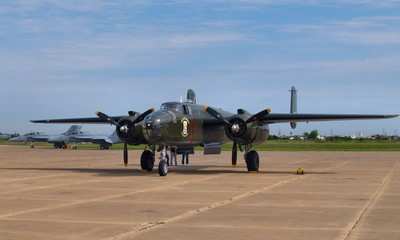
This photo is taken from in front of the left front side of
"Special Delivery." In the background, underneath the right wing
are two F/A-18 Hornets. It hit me as more than a coincidence that
the Doolittle B-25s took off from the USN Carrier USS Hornet and 65
years later, a B-25 and a couple of Hornets are in the same
photograph. The gull-wing of the B-25 is apparent from this angle.
Note the outer wing panel in this image. It is not an optical
illusion or any deformation induced by the camera lens - the top of
the outer wing has a very slight anhedral, which is the big word to
mean that the wingtip of a basically flat wing section is lower
than the root of the wing (mirrored on the other side of the
aircraft if you want it to fly straight!). The bottom of the outer
portion of the wing is "straight," but since the wing is thicker at
its root than it is at the tip, the slight anhedral presents
itself. The dihedral (angling up away from the fuselage) of the
inner wing panel is also obvious. There doesn't seem to be any
other example of major US WWII aircraft that exhibit this gull-wing
-- indeed, the inverted gull wing of the F4U Corsair demonstrates
the reverse of the angles of the wing sections. In the Corsair, the
wing exits the fuselage with fairly extreme anhedral and then
"bends" up several feet from the fuselage and this dihedral is
emphasized by the anhedral of the root.
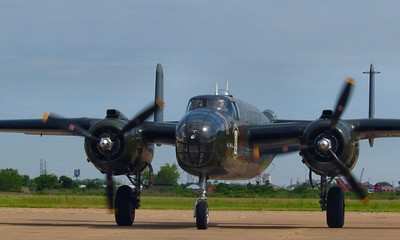
In this view, the Mitchell has just returned from one of many
flights that it made before the actual airshow began on Saturday,
4/28/07. I found out later the LSFM check pilots were checking out
a new pilot for the B-25. The rumor mill was cranking that day,
almost as much as was the pure muscle of internal combustion aero
engines. Folks all around us said the Museum had sold the B-25, and
the new owner was getting checked out in it and that would explain
all of the take-off/landing cycles we had been witnessing before
the airshow actually began. I confirmed with the LSFM staff a
little later that their B-25 was NOT on the selling block (but I
did learn that the P-38 had been sold and had been flown to its new
owner in Kissimmee, FL and that the A-20 was for sale, along with
maybe a few other aircraft that had been on extended loan to the
LSFM but were in fact owned by a private individual -- I had to get
my "hangar talk" verified before I reported anything to ANN
readers!).
Back to the numerous take-off/landing cycles of the B-25: the
LSFM has maybe 10 pilots who are type-rated in the B-25, but having
one more B-25 pilot never hurts. They simply were checking out
another B-25 pilot -- case closed! Man, what I would give to get
enough time in my puny pilot's logbook, along with the necessary
ratings, to move up to fly anything besides Cessna 150s, 152s and
172s. Let's see, if I moved to Galveston, won the Texas Lotto
multi--million dollar prize and... you get the picture.
Anyway, back to the photo. They were allowing the big Wright
Double Cyclone R-2600s to "cool down" after a flight while the
pilots completed the engine shutdown portion of the flight and the
props were still turning. The absence of any nose armament is noted
in this photo.

This shot is one of those that is hard to "blow." The aircraft
is taxiing by no quicker than a fast walk... and a chimpanzee could
have made the same photo with a good camera. Not much more needs to
be said other than, "WOW, that wonderful racket" stereophonic
symphony from the R-2600s.
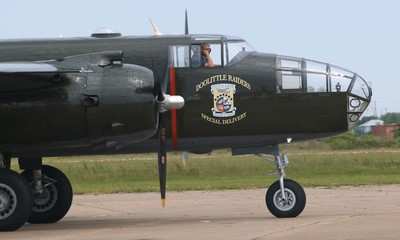
For the warbird aficionado this photo reveals the post--WWII
modifications that I have observed on all but maybe four B-25s: the
relatively tall and rectangular air intake on top of the cowling
and the seven-cylinders-into-one-pipe large exhaust pipe, and three
of the "warts" that J-pipe (some sources call them "S-pipes")
exhausts exit through the cowling (there are seven of these on each
engine, but the other four are obviously on the other side of the
cowling -- there is one J-pipe for each of the seven cylinders that
are thusly equipped).
The B-25Bs flown by the Doolittle Tokyo Raiders had a single
exhaust pipe in about the same place as the one in this photo, and
all fourteen cylinders were connected to this one pipe by way of
two collector rings. B-25 "nuts" such as I have undoubtedly read in
books and on the Internet that North American Aviation and the
USAAF even tested a small number of B-25s that were equipped with a
GE turbo-supercharger on each engine. Typical turbo hookups would
have necessitated a single pipe, so they were set to go with the
exhaust system basically "as-is." Naturally there would be other
"plumbing" to get air from the fresh air half of the turbo to the
intake side of the cylinders and more to handle air for an
intercooler. Apparently it never panned out. The intended service
altitude of this medium bomber was handled quite well by the
"usual" centrifugal supercharger that is integral with the rear end
of each engine, so it didn't adversely affect the operational
capability of the Mitchell in combat.
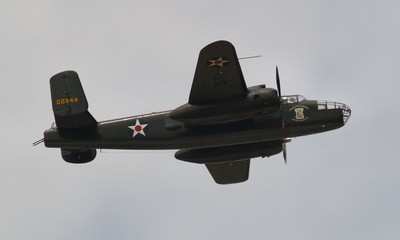
"Special Delivery" zooms past the airshow crowd at maybe 100 ft
AGL (also about 100 ft MSL since Galveston's Scholes Field is less
than 10 ft. above sea level) at maybe 200 MPH. I took maybe 40 or
50 photos of her in the many fly-by passes made over two days. Of
note in this and most other photos of the right side of the
aircraft, the photo shows a complete five-point star insignia on
the fuselage. There is a round escape hatch on the fuselage on
which most of the second point is painted. This hatch was covered
(or closed) on Saturday, but in the photos taken on Sunday, the
observer easily notices that the second point is "missing."
References tell us that this hatch is used as an escape hatch only
when the plane is on the ground -- if the plane needs to be
evacuated in flight, emergency egress is through the two "regular"
hatches in the bottom of the plane. The closed side escape hatch
will be noticed on a subsequent photo.
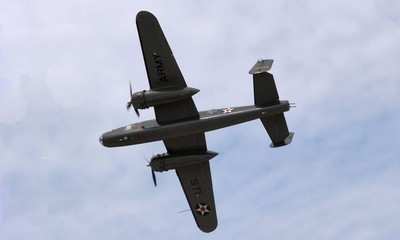
In this view, "Special D" shows off her underside. The absence
of the "packet guns" on the left side of the front fuselage is
obvious in this photo, as are the presence of seven "warts" on
Engine No. 2 (the right engine). This angle of bank, something in
the neighborhood of 60 degrees away from the viewer gives the
observer a bonus -- the sound of the engines at full throttle
really becomes a LOT louder when it's "aimed" at the observer! I
love it!
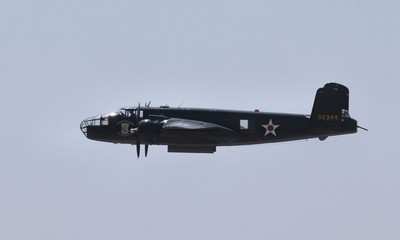
As the B-25 flies past the airshow crowd, it is obvious in this
photo the bomb-bay doors are open, simulating a bombing run during
one of the WWII reenactments that the airshow always brings. The
anhedral of the outer wing section, mentioned in the description of
a previous photo, is very apparent when the B-25 is viewed directly
from the side.
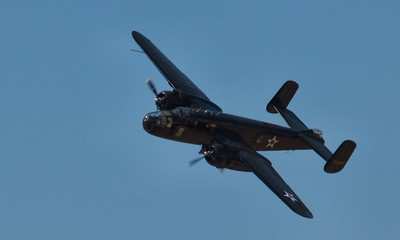
At a bank angle of about 30 degrees, "Special Delivery" shows
her stuff in one of many photo passes during the two-day long LSFM
spring airshow. Note the pitot tube on the right wing. On some
planes, the pitot tube is not only long but very different from
some of their WWII contemporaries. The Curtiss SB2C Helldiver comes
to mind. It has a unique pitot tube -- it's not only relatively
long, when compared to those on many other WWII aircraft, but it
exits the leading edge of the left wing near the tip, extends
approximately one foot straight out, then it bends upwards and to
the front and about a foot above the level of the previous section,
it then bends forward again, with the final section being a foot or
so long, paralleling the longitudinal axis of the fuselage, and
then terminates in a tip that is a blade not unlike the blade on
the tip of the B-25 pitot tube. It's almost crank-shaped. As usual,
I've gotten off the main subject... but warbird nuts really like to
focus on details.
The bomb-bay doors are open in this photo, with the left door
seen between the No. 1 (left) Engine and the fuselage. Note: the
B-25B did not have the "birdcage" for the tail gunner as seen in
this J-model B-25 (refer to later photo for close-up of the
"birdcage"). The Doolittle B-25Bs didn't need a tail gunner anyway,
because the tail guns were fakes (reportedly they were broom
handles.) In "regular" B-25Bs, the tail gunner more or less was
prone in the tail... and the newer models, such as this B-25J, had
an entirely different set-up, allowing the gunner to sit up and do
his job.
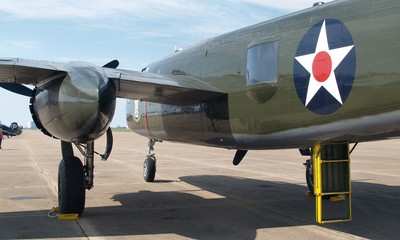
Taken from the left rear quarter view, this photo shows the
hatch/steps assembly and much of the rear fuselage. The hatch is
obviously in its open, or down, position. I've climbed into, inside
and out of B-25s before, and all I can say is that it must be
easier for the young to do! For this middle-aged guy, everything
involved in climbing into, inside of and out of warbirds is either
too tiny, too vertical or requires some kind of strange yoga
position to get the job done. Thank God that our dads, grandfathers
and maybe great-grandfathers were mostly teenagers and early
20-something year-olds when they fought in and won WWII! Probably
the only WWII warbirds that accommodates the not-so-young are the
P-39 Airacobra and its sibling, the P-63 Kingcobra. I've had the
luck to get to climb into and sit in the cockpit of a Kingcobra and
its big auto-type doors make ingress and egress a snap!
Back to the B-25 -- the steps are on slides and have to be slid
up before one swings the hatch closed. Details, details, details!
The B-25B, by the way did not have the convex waist windows (which
were on each side and operationally equipped with a single
flexible-mount .50 Cal BMG in the case of the B-25s so equipped) in
the rear fuselage as does this newer J-model, but removing them and
rebuilding this part of the aircraft would cost a lot of money and
time, and really wouldn't be worth it.
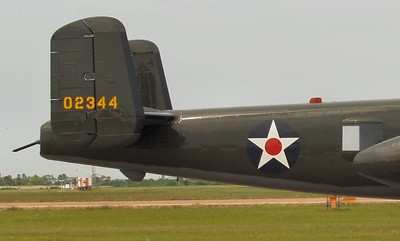
This photo shows the USAAF "Star-in-the-Circle" insignia. This
five pointed white star with dark blue background and red circle
(often called the "meatball") in the center of the star had adorned
US military aircraft for number of years. This insignia was changed
not much after the Doolittle Raid, to a plain white star on a dark
blue background, and was still a "Star-in-the-Circle." This
insignia was temporarily changed in late 1942 on some USAAF
aircraft in the Mediterranean Theater, where it briefly had a
yellow band around its border. In early 1943, the new insignia was
a "Stars and Bars" with a red border around the entire insignia. In
late 1943, the USAAF removed the red border and finally wound up
with the "Stars and Bars" insignia which was kept until after WWII.
US Navy aircraft followed these rules also. The insignia changed
again, one final time, when the US Air Force became its own branch
of the service in January, 1947.
Presently, camouflaged US military aircraft have their "Stars
and Bars" rendered in very faint colors (or shades of grey), but
non-camouflaged aircraft still maintain the vibrant Red, White and
Blue "Stars and Bars" that dates back to 1947. Getting back to
1942, the red "meatball", it is said, confused Allied service
personnel on the ground and in the air, because it looked like the
familiar Japanese Hinomaru insignia, so the then-new insignia of
the "Star-in-the-Circle" sans "meatball" was adopted and applied to
all USAAF aircraft.
Also seen in this photo is the tail number 02344 painted in
yellow. This was the serial number on Doolittle's B-25 for the
Tokyo Raid. This photo was taken on the first day of the LSFM
airshow -- I know because of the presence of the circular port
cover in the fuselage on which all of the second point of the star
is present. For some reason, the next day, the port is open
(obviously with Plexiglas in the opening) and this is evident
because this point of the star is missing. A subsequent photo of
this beautiful Mitchell in a climb with bomb-bay doors open clearly
shows this. I never got back to ask them just "why" it was one way
on Saturday and another way on Sunday. That'll be covered on my
next trip to LSFM!
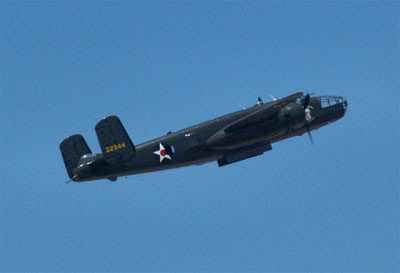
In this view, "Special D" is seen in a left-to-right fly-by that
became a climb as she passed the airshow crowd on Sunday, April 29,
2007. The bomb-bay doors are open to simulate a bombing run. Of
note in this photo is the "missing" second point on the US star
insignia. The escape hatch mentioned previously is obviously open,
and obviously the second point of the star is "gone." Blue sky can
be seen through the left waist window position. If these photos
only could have a sound file to go with them, the rumble 'n' roar
of the mighty R-2600s and the wind whistling over the aircraft
would punctuate this (and many other) photos from this recent
shoot!
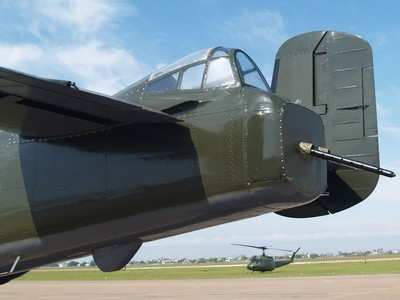
Aside from the definite two-color paint on "Special Delivery," a
few other points are evident in this view. The twin .50 Cal BMG
barrels that protruded from the tail-cone were wooden fakes in the
Doolittle B-25s, just as they are fake metal ones in this restored
B-25. I'm repeating myself but here goes, again: I've flown in this
very aircraft when she was restored as a USN PBJ - there is nothing
on the inside of the tail end of the aircraft resembling BMGs
because the general public usually never gets inside the tail. I
photographed two other LSFM aircraft that warm November day in 2002
from this and several other positions in the Mitchell -- the LSFM's
own F4U-5N Corsair "Annie Mo" and an AD-4 SkyRaider "Marlene Uncle
Ho's Nightmare" which is on loan to the Museum.
Many, many photos of warbirds in flight have been taken from the
tailcone of a B-25 with the BMGs and their bulkhead panel removed
-- the photographer is literally strapped into the tailcone in a
prone position and he or she shoots photos that are unobstructed by
often crazed or fogged Plexiglas. Maybe one day I'll get to do it
that way!
The tailgunner's position on these later B-25s allowed the
gunner to sit on a bicycle-type seat and aim the twin fifties,
because of the "birdcage" blister. In Doolittle's era, the B-25s
that were equipped with real BMGs required the gunner to lay prone
and sight the guns through a scope type sight, not a good way to
aim and fire. The later models, while the "birdcage" and bicycle
seat did give the gunner a real seat and a better gunsight, this
setup did make him more vulnerable to gunfire from the enemy.
The right vertical tail, composed of the fixed vertical
stabilizer, the fabric-covered rudder and trim tab
(aluminum-covered) along with its actuating rod, are seen. I've
read that North American Aviation tried out different shapes for
the vertical tail surfaces on the B-25 and they settled with the
fifth version. Part of the left elevator and trim tab, along with
its actuating rod, are seen in the left side of the photo. On the
underside of the rear fuselage we see the tail-skid that it is
hoped, is NEVER needed, but over-rotation on take-off or holding
the nose too high in the landing phase of flight obviously is
possible in the Mitchell, or the skid would have never been
incorporated into the airframe. Unlike that on some other WWII
bombers that also happen to be tricycle-gear aircraft (such as the
B-24 or B-29), the one on the B-25 is not retractable. In the
distance, on the other side of the taxiway is a Bell UH-1 Huey
helicopter that flew during the portion of the airshow dedicated to
the Vietnam War.
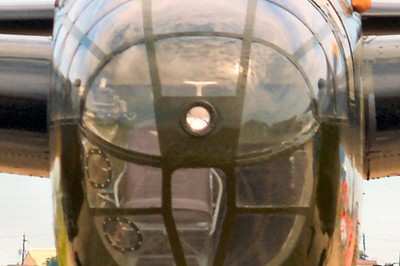
This close-up of the nose of our subject clearly shows the two
Plexiglas "plugs" that fill in the holes left behind after the two
.50 Cal BMGs were removed from the nose to make this particular
rendition of the B-25 more accurate.
 ANN's Daily Aero-Linx (04.13.24)
ANN's Daily Aero-Linx (04.13.24) ANN's Daily Aero-Term (04.13.24): Beyond Visual Line Of Sight (BVLOS)
ANN's Daily Aero-Term (04.13.24): Beyond Visual Line Of Sight (BVLOS) Airborne 04.09.24: SnF24!, Piper-DeltaHawk!, Fisher Update, Junkers
Airborne 04.09.24: SnF24!, Piper-DeltaHawk!, Fisher Update, Junkers Aero-News: Quote of the Day (04.14.24)
Aero-News: Quote of the Day (04.14.24) ANN's Daily Aero-Term (04.14.24): Maximum Authorized Altitude
ANN's Daily Aero-Term (04.14.24): Maximum Authorized Altitude



















